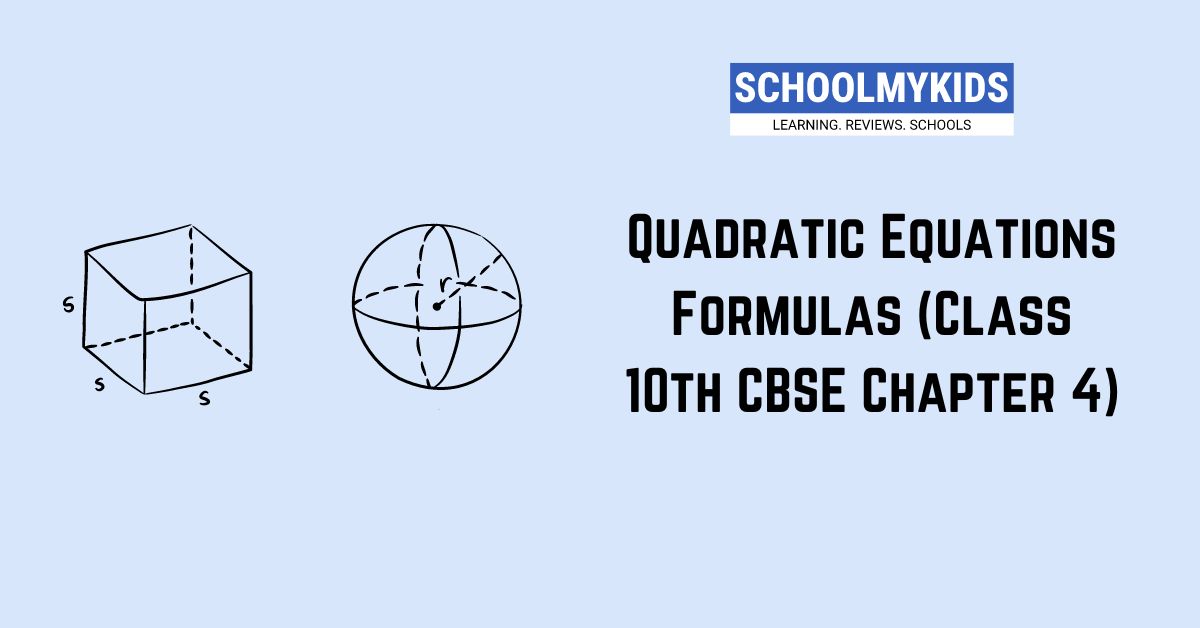In Chapter 4 of your CBSE Maths textbook, you’ll encounter quadratic equations. These are polynomial equations of the form:
ax^2 + bx + c = 0
Here, a, b, and c are real numbers, and a ≠ 0 (a cannot be zero). Let’s explore the key formulas used to solve these equations and see some examples for better understanding.
1. Quadratic Formula
This formula provides the roots (solutions) of any quadratic equation.
Roots = (-b ± √(b^2 – 4ac)) / 2a
where:
- a, b, and c are the coefficients from the quadratic equation (ax^2 + bx + c = 0).
- √ represents the square root.
Examples:
- Example 1: Solve x^2 + 6x + 5 = 0
Here, a = 1, b = 6, and c = 5. Applying the formula:
Roots = (-6 ± √(6^2 – 4 * 1 * 5)) / 2 * 1 = (-6 ± √(16)) / 2 = (-6 ± 4) / 2
Therefore, the roots are x = -1 and x = -5.
- Example 2 (Real and Different Roots): Solve 2x^2 – 3x – 2 = 0
Following the formula with a = 2, b = -3, and c = -2, we get:
Roots = (-(-3) ± √((-3)^2 – 4 * 2 * -2)) / 2 * 2 = (3 ± √(17)) / 4
This equation has two real and different roots.
2. Nature of Roots based on Discriminant
The discriminant (represented by the symbol Δ) helps determine the nature of the roots.
Δ = b^2 – 4ac
- Δ > 0: Two real and different roots. (As seen in Example 2)
- Δ = 0: Two equal real roots.
- Δ < 0: Two complex roots (roots involving imaginary unit ‘i’).
Examples:
- Example 3 (Equal Roots): Solve 9x^2 + 12x + 4 = 0
Here, a = 9, b = 12, and c = 4. Calculating the discriminant:
Δ = 12^2 – 4 * 9 * 4 = 0
Since Δ = 0, this equation has two equal real roots.
- Example 4 (Complex Roots): Solve x^2 + 2x + 5 = 0
Here, a = 1, b = 2, and c = 5. The discriminant:
Δ = 2^2 – 4 * 1 * 5 = -16 (negative)
As Δ < 0, this equation has two complex roots.
Short Notes:
- Remember the standard form of a quadratic equation (ax^2 + bx + c = 0).
- Use the quadratic formula to solve for the roots of any quadratic equation.
- The discriminant (Δ) helps determine the nature of the roots (real/complex, different/equal).
- Practice with various examples to solidify your understanding.
Relationship between Roots and Coefficients
The quadratic formula not only provides the roots but also unveils a connection between these roots and the coefficients (a, b, and c) of the equation.
- Sum of Roots: The sum of the roots of a quadratic equation is equal to negative of the coefficient of the linear term (x) divided by the coefficient of the quadratic term (x^2). In simpler terms:
Sum of Roots = -b / a
- Product of Roots: The product of the roots of a quadratic equation is equal to the constant term (c) divided by the coefficient of the quadratic term (x^2).
Product of Roots = c / a
These relationships come in handy for various applications, such as verifying solutions or forming quadratic equations from given roots.
Examples:
- Example 1 (Verifying Solutions): Consider the equation x^2 + 6x + 5 = 0 (as in the previous section). We found the roots to be -1 and -5. Let’s verify this using the sum of roots formula:
Sum of Roots = -b / a = -6 / 1 = -6
Since -1 + (-5) = -6, the calculated roots are valid.
Forming Quadratic Equations from Roots
Given two numbers (α and β) as the roots of a quadratic equation, you can use the following formula to construct the corresponding quadratic equation:
x^2 – (α + β)x + αβ = 0
This formula essentially reverses the relationship between roots and coefficients.
Example 2 (Forming a Quadratic Equation): If the roots of a quadratic equation are 3 and -2, what’s the equation?
Following the formula with α = 3 and β = -2:
x^2 – ((3) + (-2))x + (3)(-2) = 0 x^2 – 1x – 6 = 0
Therefore, this is the quadratic equation with the given roots.
Applications of Quadratic Equations
Quadratic equations have diverse applications in various real-world scenarios. Here are a few examples:
- Projectile Motion: Quadratic equations can model the trajectory of a projectile considering factors like initial velocity and acceleration due to gravity.
- Word Problems: Many word problems involving maximizing/minimizing quantities or finding unknown dimensions can be solved by forming and solving quadratic equations based on the given conditions.
- Circuit Analysis: When dealing with voltage and resistance in electrical circuits, quadratic equations can help calculate currents or resistances in specific configurations.
By understanding these concepts and practicing with various problems, you’ll gain a deeper appreciation for the power and versatility of quadratic equations in mathematics and beyond.
Summary of Important Formulas:
Here’s a quick reference for the key formulas:
- Standard Form: ax^2 + bx + c = 0 (a ≠ 0)
- Quadratic Formula: Roots = (-b ± √(b^2 – 4ac)) / 2a
- Discriminant: Δ = b^2 – 4ac
- Sum of Roots: -b / a
- Product of Roots: c / a
- Forming Equation from Roots: x^2 – (α + β)x + αβ = 0 (α and β are roots)









Be the first one to comment on this story.